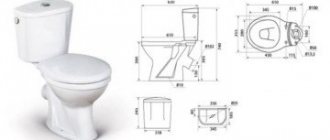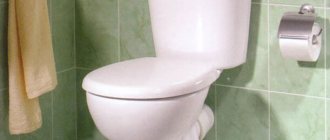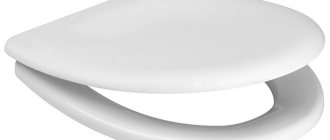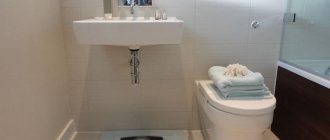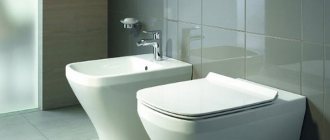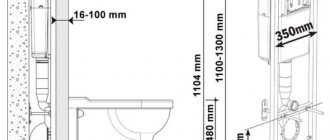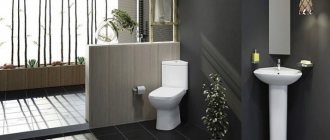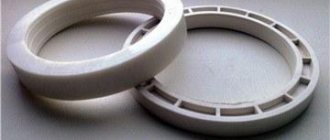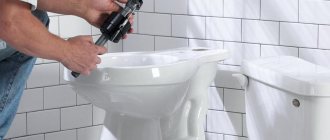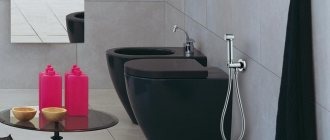The dimensions of the toilet installation depend on technical and technological factors, installation method and product configuration. In other words, on the frame structure you need to install a 6 - 9 liter flush tank, a sewer pipe, a cold water supply, a block with shut-off valves and a drain button. The frame itself is welded from a 40x40 mm profile pipe.
Therefore, the dimensions of the width, depth and height of the installation are interdependent. They cannot be reduced below certain values. Moreover, a decrease in one of the parameters inevitably leads to an increase in the other.
Let’s make a reservation right away: in this article we are considering only frame installations, block installations (for embedding into the wall) will not be considered here.
Device and classification
Shape of the outlet pipe of the drainage system
The following types of pipes are distinguished:
- Oblique (angular) or “outlet into the wall”
- Straight or horizontal
- Vertical or “floor outlet”
Type (shape) of the bowl
The standard is considered to be plumbing fixtures with a funnel-shaped, visor-shaped and dish-shaped bowl (see figure). The plate version can be considered obsolete despite its infrequent, but still presence in construction stores.
Funnel-shaped and visor have their own pros and cons. One form is good for everyone, but it splashes a lot, the other has almost no splashes, but more often a brush is required and the noise level is higher when draining water.
Flush cistern
Sanitaryware is also divided according to the installation method. Classics of the genre are floor-mounted and wall-hung toilets, which can be found in both corner and wall-mounted versions. It’s quite easy to get confused in such a variety, so let’s look at the standard sizes that you can use when choosing plumbing fixtures.
Do you know?
That the word “toilet” appeared quite recently. The Spanish company Unitas launched mass production of plumbing products made of earthenware 1909 Later, the word toilet began to be used to refer to any sanitary and technical device, regardless of the manufacturer.
Types of installation systems
The installation of a wall-hung toilet is nothing more than a steel mounting frame in which communications and a flush cistern are hidden. The structure itself goes deep into a niche or is covered with an additional false wall. Photos of the two types of installations well illustrate the difference between them.
Advice. The installation can be used to mount both a toilet and other plumbing fixtures – a sink and a toilet.
Types of installation systems:
- Block. Installation of such an installation is only possible on a load-bearing main wall; interior partitions are not suitable. The system consists of a plastic tank, mounting plates with anchors and a set of studs for attaching the toilet. This is a more affordable option.
Block installation system for wall-hung toilet - Frame installation - This is a permanent fastening structure with a tank and a communications supply. The frame installation can be installed anywhere in the room, regardless of the presence and strength of the walls. It is attached to walls, floors, or a combination of four points. There are corner modifications that are installed at the junction of two walls. The only significant drawback of this type of installation is its high cost.
Frame installation
Choose your size
Standard dimensions of a floor-standing toilet
If we talk about standard toilet sizes, domestic manufacturers try to adhere to the following sizes:
| Product type | Length, cm | Height, cm | Width, cm |
| Floor-standing toilet with a solid cast shelf (for securing the cistern) | 60,5 | 34 | 32 — 37 |
| Toilet without a solid cast shelf | 33-46 | 36 | 30 — 35 |
It is important to understand that these are “bare” dimensions, without additional accessories. Considering that in most cases, the toilet comes complete with a tank, the overall dimensions increase proportionally.
It is worth noting that the height of the tank may vary depending on the country of origin. For example, the accepted European standards are considered to be dimensions 680*360*400 for the depth (length), width and height of the toilet rim, respectively.
Hanging sanitary fixtures
| Product type | Length, cm | Height, cm | Width, cm |
| Wall-hung toilets (consisting of a bowl only) | 48 — 70 | 35 — 40 | 35 — 37 |
Recently, such models of plumbing fixtures are gaining steadily growing popularity. The advantage of wall-hung toilets is that the water supply is hidden in the wall, so the design of the bathroom is not disturbed. In addition, the hinged structure visually expands the internal space. It is worth noting that such models are very resistant to static loads and can withstand up to 400 kg . Some manufacturers provide a double safety margin ( up to 800 kg ).
It is worth noting that installing a wall-hung toilet greatly simplifies cleaning the premises.
Wall-hung plumbing comes complete with an installation - a special mounting structure, the dimensions of which are indicated in the article below.
Corner products made of sanitary ceramics
Such models are often installed in small residential buildings and industrial buildings. Thanks to the corner installation, the toilet not only saves internal space, but also partially hides utility lines. The following standard sizes are relevant for such models:
- Height: 37 – 43 cm
- Depth: 72.5 – 79 cm
- Width: 34.5 – 37.5 cm
When choosing a size, you must take into account the width of the corner.
Dimensions of built-in toilets
Such models are characterized by a hidden installation of the cistern. This element is hidden by a false panel or built into the wall. Thanks to the installation features, built-in toilets operate virtually silently.
When choosing plumbing, you can be guided by the following parameters:
- Height: 39 – 42 cm
- Depth: 47 – 58 cm
- Width: 35.5 – 37 cm
It is worth noting that built-in toilets are found on the market in floor-mounted and wall-hung versions.
Installation - specialized mounting structure
- Frame . Depth: 135 - 300, height - 800 - 1,400, width - 500 - 600 mm.
- Block . Depth: 100 - 150, height - up to 1,000, width - 500 - 600 mm.
Toilet - bidet: two in one
Plumbing fixtures that combine the functions of a toilet and a bidet are almost impossible to find in standard apartments: they are a rare guest on the domestic market. However, such models are very convenient to use, therefore they are widely used in cottages and apartments built according to individual projects. Typically, shower toilets differ from standard products in their larger dimensions and increased volume of the flush cistern.
The general dimensions of such products can be as follows:
- Floor installation : 700/410/785 (length/width/height). Along the toilet rim – 390 mm .
- Hanging (hidden installation): 485/355/315 (length/width/height).
Most shower toilet models have water pressure regulators and thermostats.
Large toilets
Such products are intended for people with excess body weight. Large toilets differ from standard models and can be made to order. The following parameters are considered standard dimensions:
- Height – 65 cm
- Depth – 70 cm
- Width – 40 cm
The design of such toilets is usually reinforced, so they can withstand loads of up to 500 kg .
The most compact toilets
If we talk about non-standard sizes, it makes sense to consider the parameters of small-sized products. Narrow, small toilets are ideal for installation in small bathrooms. Here you can use the following dimensions:
- Width – from 33 cm
- Depth – from 59 cm
- Height – from 47 cm (with tank)
Among small-sized plumbing fixtures, toilet bowls with a size of 35*63*77 cm , but here it all depends on the installation location and personal preferences. Thanks to their compact dimensions, such toilets look natural even in small toilets.
Children's toilet sizes
If the size of the bathroom allows, you can install an additional mini toilet for children. Usually these are compact models that do not take up much space. When choosing children's plumbing, you can be guided by the following dimensions:
| Product type | Length, cm | Height, cm | Width, cm |
| Special products for use by small children | 28-40,5 | 13-33,5 | 21-29 |
The height of the toilet is chosen so that a person’s feet are confidently on the floor. This is the only way to achieve the most comfortable position. A special stand can be used for children:
After choosing and purchasing the optimal size toilet, the process is just beginning. Below we provide related information that will be useful to you.
Standard models
The installation height should ensure a distance from the floor covering to the top edge of the toilet sides of 40 cm, as this is the international standard. Accordingly, from the finished floor to the axis of the sewer pipe, the size is maintained at 229 ± 1 mm.
The tank is always located above the drainage system; its volume is from 6 liters, which is the standard amount of water for normal flushing of solid waste. Some companies provide a water supply of 3 liters, while the volume of the tank increases to 9 liters. Or they offer economical models of tanks with a small flush volume - 2.4/4 liters.
Installations of 80 cm are the lowest, with either the thickness of the tank or its width increasing, often a little of both of these sizes. To obtain narrow installations, you will have to increase the height and thickness of the flush tank.
The standard dimensions of a frame installation are considered to be a height of 110-120 cm, a width of approximately 50 cm and a thickness of 12–15 cm. In this case, the thickness is indicated in the documentation without taking into account the sewer pipe, the outer diameter of which is 110 mm.
From the manufacturer Grohe, the standard dimensions of Rapid SL frame installations are 1130 mm in height, 500 mm in width and 130 mm in depth at the top, as in the drawing below:
The installation depth can be adjusted up to 230 mm.
At the same time, models may differ in the design of the tanks and equipment (sound insulation, smart panels, other additional options). Design features are:
Roca offers a collection of frame structures in standard sizes:
- Duplo WC - width 500 mm, height 1090, depth 140 - 195 mm;
Duplo WC
- Duplo WC Smart – width 500 mm, height 1190, depth 140 – 195 mm;
Duplo WC Smart - Duplo WC Freestanding – width 500 mm, height 1120, depth 160 mm;
Duplo WC Freestanding
Dimensions of the basic Tece - TeceProfil: width 500 mm, height 1120 mm, depth 150.
The basic model from Alcaplast - Sadromodul AM101/1120 has dimensions: 1120 mm (height), 510 mm (width) and 125 mm (depth).
Tece also has a model Jadromodul AM102/1120 for installation in panel houses - it has additional legs for side-by-side installation in standard toilets (from 830 to 1200 mm);
Geberit brand has standard dimensions for frame installations of 120 mm (thickness), 500 mm (width) and 1120 mm (height) with the ability to adjust within 200 mm vertically. In total, the company has developed three series of similar hidden installation systems:
- budget Delta - the open-type frame does not have a crossbar on top, the release keys are plastic, made in three basic colors;
Delta
- elite Sigma - frame with top crossbar, more than 80 design options for drain buttons;
Sigma
- universal Omega - only one model out of three has standard dimensions; it differs from the previous version of the Sigma series only in the design of the tank.
Omega
Manufacturer Cersanit:
- Installation of AQUA 40
AQUA 40
- Installation LINK PRO
LINK PRO
The manufacturer Viega calls frame installations “prevista dry toilet elements”. The standard dimensions at this enterprise are 1120 mm in height, 500 mm in width and 120 mm in installation depth.
There are options with additional supports, fastening studs to the wall, and the ability to bleed air into the ventilation exhaust manifold from the toilet bowl.
Please note: the actual installation depth of installations starts from 150 mm, regardless of their thickness, this is due to the diameter of the sewer pipes - 110 mm. Therefore, installation thicknesses of less than 150 mm only make sense if pipes pass behind the tank itself.
How to choose a lid and toilet seat
To choose a suitable toilet seat, you need to know exactly the dimensions of the plumbing fixtures. It is believed that the lid should exceed the dimensions of the toilet by about 0.5 centimeters , however, this is not a necessary condition. To make accurate measurements, you need to find out three main parameters:
- Distance between mounting holes.
- The length from the fastening axis to the end of the cover.
- Distance from the mounting axis to the outer rim of the toilet.
In addition, you need to take into account an important nuance: the shape of the lid must match the rim of the toilet.
Seat - pad with handrails
Convenient modifications of lids with handles are provided for disabled people:
What is this mysterious microlift?
For ease of use of plumbing fixtures, additional accessories are sometimes included in the design of the toilet. One of these elements is a microlift. According to technical parameters, a microlift is similar to a regular door closer and performs similar functions. The task of the microlift is to ensure smooth lowering of the lid onto the toilet rim, excluding sharp impacts that can damage the toilet seat and ceramics.
Toilets with a microlift can be found in any plumbing store; the installation of this element has virtually no effect on the cost of the product.
Installing a wall-hung toilet yourself
You can install a wall-hung toilet with installation yourself. To do this, you need to have the necessary tools and develop a clear algorithm of actions. The further uninterrupted operation of the entire system will depend on correct and reliable installation. Do-it-yourself installation requires a detailed study of the instructions for a specific model; it would be a good idea to watch videos with master classes and photos.
Installation installation procedure
It is very important to follow the sequence of installation work and perform all stages efficiently. Installation procedure:
- accurately make all the necessary measurements;
- apply markings to the wall;
Be sure to mark before installation
- install and secure the installation;
- connect water pipes and sewerage;
- install a toilet.
Important! All installation work must be carried out after laying communications and bringing them out for connection
Installation of the installation is carried out strictly before finishing work begins. There is no need to rush during installation. It’s better to check everything thoroughly than to redo the repairs in the toilet later.
Required Tools
Do-it-yourself installation of a wall-hung toilet with installation does not require the purchase of expensive professional tools. The basic tools available in the arsenal of every owner will be sufficient:
- pencil;
- level;
- roulette;
- hammer drill with a set of drills for concrete;
- open-end wrenches of the appropriate size;
- fum tape;
- sealant.
Installation fastening
Applying markings for mounting the installation
When the installation location has been chosen, the installation has been purchased, the theory has been studied (video and photo), installation can begin. The first step will be to apply markings. It is on this that the installation will be installed.
- Draw the vertical centerline of the installation.
- Mark the distance of the installation from the wall, which depends on the method of sewerage connection and the location of the sewer outlet pipe. The gap between the installation and the wall cannot be less than 13.5 mm.
- Mark the attachment points for the cistern. The standard mounting height for a cistern under a wall-hung toilet is 1000 mm. This size may vary depending on the type and size of the installation.
- Depending on the mounting method, mark points on the wall or floor for fastening.
Drawing: frame installation
Other installation installation parameters:
- bowl installation height - 400-420 mm;
- installation height of the drain button – 950-1000 mm;
- protrusion of the sewer pipe above the floor – 200-230 mm;
- the play between the tank and the wall (after installing the installation) is 15-20 mm.
Installation installation
Regardless of the type of installation, special attention should be paid to fastening elements, because the strength of the entire structure will depend on them. Using pre-applied markings, holes of the appropriate size are drilled in the wall and floor using a hammer drill. Dowels are inserted into the holes, and then mounting anchors.
Installation installation
Important! If the installation is being installed in a private house with wooden walls and floors, screws are used for fastening. In some cases, additional rigid fastening from a metal corner is necessary.
Securing the installation
- The frame is attached to the prepared fasteners, primarily to the floor.
- The entire structure is strictly leveled in all directions.
- The level-adjusted frame is fixed using plugs.
This will be required during installation. Corrugation and cuff
When installing a toilet, corrugations and cuffs are used in accordance with the shape of the outlet pipe of the drainage system. Generally accepted standards apply here and should be taken into account during installation.
- Corrugation . Used to drain into the public sewer system. The length of the corrugation is usually 200-1,200 mm , diameter: 130 mm connection to the toilet, 110 mm connection to the sewer.
- Cuff . The element is designed for a sealed joint between corrugation and plumbing. The length of such products varies between 112-130 mm , the diameter is selected in accordance with the mounting location.
Features of the sizes of children's toilets and compact class models
Small toilets are often installed in rooms where families with children live. In addition, such models are also preferred by lovers of minimalist style interiors, even when the parameters of the bathroom allow the installation of a larger model. This is due to the fact that the main task of the style is to design a functional space and at the same time leave the maximum amount of free space. In general, the following sizes of compact toilets are distinguished:
- width – 290-350 mm;
- length – 460-590 mm;
- height – 260-340 mm.
When choosing the size of a children's toilet, you should take into account not only the age, but also the weight, as well as the body type of the child. We must not forget that children grow quickly, so you should choose a device in advance with a 20-25% margin of size.
Plumbing experts say that a special children's toilet can only be installed if there is enough free space in the bathroom. Otherwise, you should choose a special toilet cover that will make it convenient for your child to use the plumbing. Nowadays, even pads with ladders have been developed that help the baby climb onto the toilet without the help of adults.
Plumbers recommend installing a children's toilet only if there is enough free space in the toilet
Installation diagram
Fastening suspended plumbing fixtures is a reason for a separate detailed article. With floor-standing models everything is much simpler. Toilet bowls are placed on special glue (for example, “heavy duty” in yellow tubes) or attached to bolts with holes drilled in the floor. This process is shown schematically below.
To make sanitaryware comfortable to use, the distance to the toilet door must be at least 60 centimeters , the recommended space to the walls is 35 cm .
Basic rules for choosing the size of a toilet: photos of attractive bathrooms
Many people, when choosing plumbing fixtures, do not take into account the dimensions of the toilet, paying attention only to the quality of workmanship and other technical capabilities. Experts consider this approach to be incorrect, because if you choose the wrong sizes of plumbing fixtures, it will be inconvenient to use, which will cause significant discomfort.
To sit comfortably on the toilet, there must be at least 60 cm of free space in front of it
Interesting information! The first toilet with a cistern was developed back in 1596 by Sir John Harrington in Great Britain. The first owner of plumbing was Queen Elizabeth.
When choosing the optimal dimensions of a toilet, it is first recommended to pay attention to the following points:
- After installation, the size of the toilet should not interfere with normal movement around the bathroom. It is required that the device does not become an obstacle when opening the front door or cabinet doors.
- For a convenient location on the toilet, there should be at least 60 cm of free space in front of it, but in general this figure depends on the height of the person who most often uses the plumbing. If the distance is small, then the knees will rest either against the wall or against other furniture.
- The height of the toilet determines how comfortable it will be to sit on it. The correct installation height is when, in a sitting position, the feet are on the floor and not hanging in the air, otherwise you will not be able to relax calmly, and your legs will be in constant tension.
- When choosing the width, you also need to focus on the physique of the person who uses the plumbing fixture more often than others. The main thing is that there is no pain in the muscles while sitting. So, if the rim is too narrow, the edges will constantly put pressure on the legs, but if the rim is too wide, the legs will quickly become numb.
The correct height for installing the toilet is when, in a sitting position, the feet do not hang in the air, but are on the floor
An equally important parameter is the weight of the structure, which is influenced not only by the size of the toilet, but also by the type of material from which it is made. The following are considered average parameters:
- earthenware products – 26-31.5 kg;
- porcelain toilets – 24.5 – 29 kg;
- weight of stainless steel plumbing – 12-19 kg;
- marble models are considered the heaviest, their weight is 100-150 kg;
- The lightest is plumbing fixtures made of special plastic – 10.5 kg.
It is worth noting that wall-hung models have less weight than compact toilets with a cistern, because they are characterized by the absence of a leg. In general, the weight of toilets is affected by the size and capacity of the tank, which varies from 6 to 11 liters. Product weight indicators are considered very relevant, especially when installed in dilapidated old houses or on the second floors of private houses.
Which edition should I buy a toilet with?
Wario Issue
» is universal and can be installed on any sewerage connection option. In my selection of toilets, this is the Sanita “Lux” model.
For sewerage coming out of the wall horizontally, a toilet with direct outlet or “Vario” is required.
This photo shows that you need a toilet with an oblique outlet at 45 degrees. "Vario" is also suitable.
When the sewer outlet is in the floor, "Vario" will do, but everything needs to be measured and provided for.
Common mistakes when choosing
When determining the standard dimensions of the purchased toilet with a tank, you should take into account where it will be located, as well as carry out preliminary measurements. The main mistake is failure to maintain the optimal distance from the walls to the equipment itself, which entails inconvenience in operation or does not fit into the dimensions of the room. The toilet bowl should be located at a distance of 30-40 cm from the side walls or bathtub, and the distance between the front wall/door and the edge of the bowl should be more than 55-60 cm.
Often, owners do not take into account the type of sewer entrance; it can be oblique, horizontal and vertical. And the section of pipe from the back wall to the entrance to the bowl determines the distance at which it must be installed. It is important to consider that when choosing the size of a toilet with a cistern, a standard solid-cast shelf increases the distance at the back.
What to observe when taking measurements
When taking measurements, it is important not to make a mistake, to note everything accurately. This can sometimes be difficult, so pay attention to the following guidelines when taking measurements:
- A device with an oblique drain is suitable for you if your sewer system has a common type, that is, located near the walls. This will help save a lot of time, because their installation is usually not difficult;
- To select a suitable cuff or other connecting fastener, do not be lazy and find out what the distance is from the exhaust system to the sewer drain;
- When connecting, make the hose or tube that connects the outlet of the water supply system and the outlet valve of the tank as short as possible. This will make installation easier.
We described everything about the choice, how to install it and sequential measurements. You can choose a toilet for yourself and be satisfied with your choice.
Currently reading
- Instructions for removing the lid from the toilet cistern with your own hands
- How to fix a leak in a toilet tank yourself
- A fresh solution for installing a toilet built into the wall
- Causes and solutions to toilet cistern fogging
Bowl shape
From the flush to the bowl shape. This is also very important if you want to choose the right toilet. If the shape of the bowl is incorrectly selected, even the smoothest working circular flush may not cope with the task assigned to it.
Funnel-shaped
The most optimal option for the bowl shape, which, due to the drain hole located strictly in the center, ensures quick and good cleaning and, moreover, eliminates the appearance of splashes in the process.
Do you want to forget about what a brush is? Buy a toilet with a funnel-shaped bowl. Disadvantages, of course, can be found for almost any form, but there are none here. The only difference is that such toilets cost a little more, but this is a disadvantage that is easily offset by the pleasure of use.
Disc-shaped
A somewhat controversial solution that requires a larger volume of water for flushing. Human waste products first fall into the recess - and only then, under pressure from the water from the tank, are washed into the hole. Unfortunately, this shape of the bowl contributes to the occurrence of splashes, and the question of saving water remains open. Often it is necessary to additionally adjust the volume of water for flushing. Why such difficulties, you ask? The dish-shaped bowl, however, remains relevant due to the lower price of toilets in which it is present. The most budget models are equipped with it.
Kozyrkovaya
Unlike a plate bowl, this type of bowl does not have a recess in front of the drain, but, on the contrary, a protrusion. This allows the bulk of the sewage to go directly into the drain, and the remainder is easily washed out by the pressure of water from the tank. This bowl shape is steadily gaining momentum and is increasingly found even in relatively inexpensive models.
The question of how to choose the right toilet affects not only the shape of the bowl, the type of fastening and all the key points that we discussed above.
Flush type
When thinking about which toilet is better to choose, many people rightly pay attention to the type of fastening, sewer outlet and completely lose sight of the flush system installed in a particular model.
Perhaps the most famous option is direct flush . It is often called differently - cascade, horizontal , but don’t let this fool you - this is still the same widespread (since the times of the Soviet Union) flushing system, in which the water has a straight flow path and descends evenly along the wall of the bowl to the bottom drain.
Young people scold this type of flushing, and rightly so: the fact is that it has outlived its usefulness. During such a descent, the inner surfaces of the bowl remain untouched, which allows impurities and, of course, bacteria to accumulate there.
But every cloud has a silver lining - direct flushing allows the water flow to gain a pronounced intensity and purification along the flushing path is almost 100%.
The basis of a circular flush, or, as it is also called, a reverse-circular flush, is a completely different water supply system: it moves along a ring-shaped gutter and methodically washes the entire area of the thicket.
Young people really like this kind of flushing system, because with it you don’t need to use a brush for a long time - the flow of water reaches the most difficult areas of the bowl. True, in particularly difficult cases you will still have to pick up an auxiliary tool: due to the annular trajectory, the flow loses some pressure and some impurities may remain noticeable. But this already depends on the shape of the bowl, which we will talk about below.
As a rule, toilets with a circular flush system are more expensive. Recently, there has been a tendency to replace the technically outdated direct flush with a circular one.
Apparently, this is justified by time, right?
